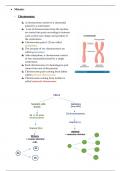Summary
Meiosis - Life science GR 12 IEB notes/summary.
- Course
- Institution
This document contains notes and summaries made during class which summarizes: The process of Meiosis I & Meiosis II; chromosomes; disorders associated with meiosis and the difference between mitosis and meiosis.
[Show more]



